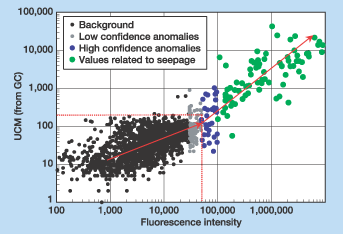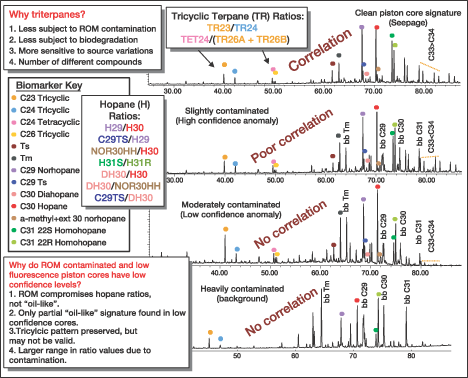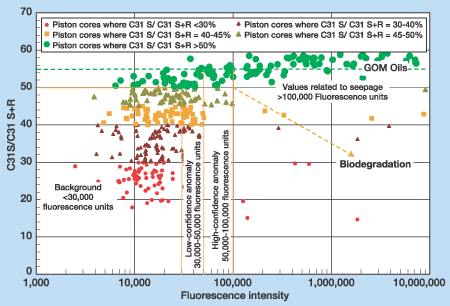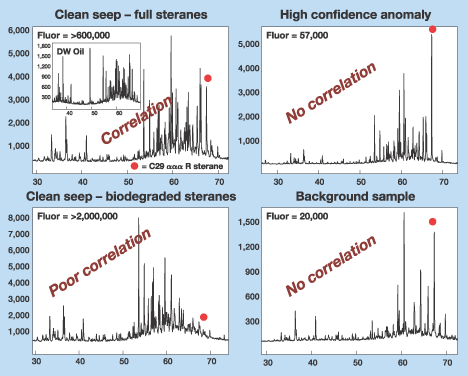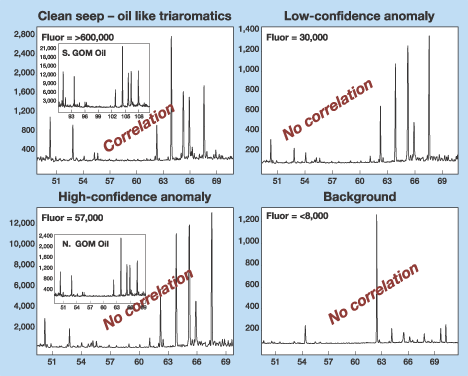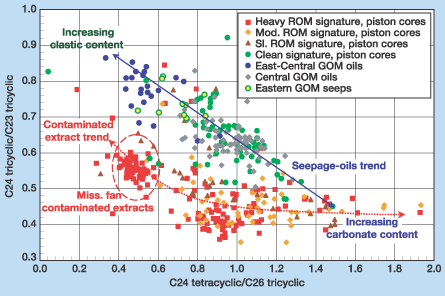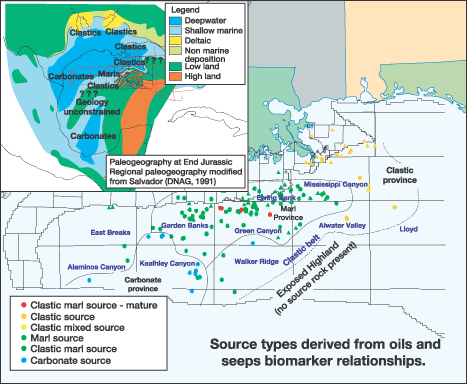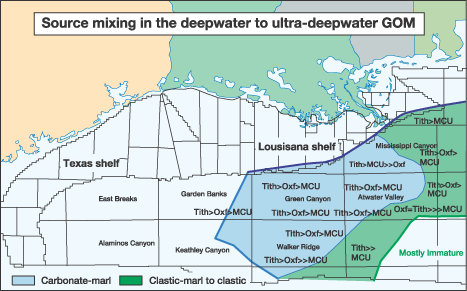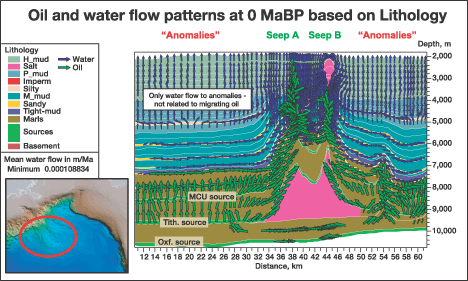Constraining source and charge risk in deepwater areas
EXPLORATIONConstraining source and charge risk in deepwater areasA new source / charge model, based on geochemical analysis of piston cores and other data from the deepwater Gulf of Mexico, indicate when seeps are related to underlying reservoirs – and when they are notG. A. Cole, A. Yu and F. Peel, BHP Petroleum, Houston; R. Requejo, Geochemical Solutions International, Inc., Houston; J. DeVay, Phillips Petroleum, Houston; J. Brooks and B. Bernard, TDI-International Inc., College Station, Texas; J. Zumberge and S. Brown, GeoMark Research Inc., Houston
This article will present how regional data, paleo-reconstructions, seepage data via piston coring and 2-D burial history / thermal / fluid-flow basin modeling have typed source-rock characteristics across the deepwater and ultra-deepwater Gulf of Mexico (GOM), and how this helps constrain source type and presence. Also discussed are new definitions of seepage related to petroleum systems vs. unrelated anomalies, how this helps constrain charge, and how all of these data were integrated to define a source-rock model for the deepwater to ultra-deepwater GOM. Elements of Risk The elements of risk for a petroleum system are discussed herein. Source. Source rocks in deepwater to ultra-deepwater parts of basins are generally not penetrated by wells, due to high drilling costs and source burial depths. Therefore, source has to be addressed regionally by inferring source type and quality through analog basins, available data from the Deep Sea Drilling Program, shelf or onshore well data, paleo-reconstructions, or by inferring source type and quality from seepage and oil shows / accumulations on the shelf. Risks are associated with each method, because source-rock characteristics must be assumed. The best method is to integrate all data from nearby wells, seepage and available oils to infer a most likely source-rock type, then sensitivity test these characteristics for migration and charge risks using fluid-flow models. Maturity and charge. Since most deepwater and ultra-deepwater wells only penetrate the upper 2,000 – 3,000 m of sediments, there is usually a lack of data regarding source-rock maturity. To determine maturity of potential source-rock intervals, either 1-D or 2-D models need to be constructed and calibrated. To calibrate these models, corrected bottom-hole temperatures or surface heat-flow probes need to be used. Alternatively, maturity relationships from seepage and oil data can be used; however, these only provide a minimum maturity since they represent a migrated fluid. Charge. Migration and charge in deepwater to ultra-deepwater basins is best addressed through calibrated 2-D fluid-flow models. Results from these models assume a good source-rock model, carrier bed system, and that overall burial history is thoroughly understood. Background Gas "sniffer" surveys1,2 and seabed piston-coring surveys have been used to identify both offshore oil and gas seepage for several decades.3,4,5 These techniques help determine the presence of near-surface hydrocarbon seepage, which can then be related to exploration objectives. In the late 1980s to early 1990s, the use of petroleum seepage was updated and placed in a petroleum system context. Seepage can now be related to several petroleum-system elements, such as source presence, minimum source maturity and hydrocarbon migration, especially since most basins are now covered by 2-D or 3-D seismic surveys. These three geochemical elements can then be assessed in even greater detail by employing other tools, such as 2-D and 3-D modeling, to determine timing and hydrocarbon flow within the basin architecture; in turn, potential structures and traps can be evaluated and risk assessed. Piston coring has been used since the early 1980s to help determine the presence of a working petroleum system in offshore areas. Piston coring studies have been conducted in the GOM, offshore Trinidad, offshore West Africa, offshore Brazil and many other areas. Initially, piston-core locations were sited on grid programs, or at best were located on interesting seafloor anomalies from 2-D seismic, such as:
Today, 3-D seismic offers the best success for finding seepage, especially via seafloor amplitude extractions. In the past, piston coring extract screening data was used alone to define background values vs. anomalous values vs. seepage, based on Total Scanning Fluorescence (TSF) and quantified Unresolved Complex Mixture (UCM) from gas chromatography (GC). These cutoff values generally ranged between low background and anomalous values; they differed from company to company, some being as low as 5,000 TSF units for the deepwater GOM and <50 ng/g for UCM from GC. GOM Case Study Recently, a more rigid classification scheme has been suggested, based on the amount of thermogenic, high-molecular-weight hydrocarbons compared to recent organic matter contamination (ROM).6 These values were considerably higher than those used in the past, which were about 50,000 TSF units and >100 ppm UCM. However, this can be refined even further based on full assessment of the screening data and use of saturate and aromatic biomarkers, and then how the interpreted seepage relates to the subsurface fluid-flow system. Biomarkers from piston-core extracts can be used to correlate to subsurface oils within a petroleum system. The extract signatures that type directly to an oil family are indicative of the petroleum system, whereas anomalous values from the extracts that do not type to the oils are excluded as seepage and are treated as background or untruthed anomalies, either of low or high confidence, depending on their detailed geochemical signatures. That is the premise for this research: only those piston-core extracts that can be typed to the active, trapped oil system can be treated as true seepage, and these must then be fully integrated to the subsurface petroleum system through models. Therefore, if the piston-core extract data cannot be typed to the active petroleum system, then these values will not be used to mitigate a prospect or play-fairway charge risk. For this article, only piston coring data from the central and eastern deepwater GOM were used, which comprised more than 2,000 locations. Screening data were acquired on three sections of each piston core and included TSF, GC and headspace gases. For active seeps, it has been found that headspace gases are adequate for characterizing the gas system (either associated or non-associated, though headspace plus occluded gases also provide adequate data). Screening data derived from the extracts provide initial cutoffs for characterizing oil seepage, this is then truthed using biomarkers. Fig. 1 plots TSF against UCM, where most values below 50,000 TSF (500,000 TSF using the new instrument scale) and <200 ppm UCM form a large cluster. Therefore, most samples below these thresholds may be background and not indicative of migrating hydrocarbons. The first divergence from this group occurs above the 50,000-TSF and 200-ppm UCM thresholds, consistent with Abrams and Segall.6
ROM contamination. To further test the usefulness of these TSF and UCM thresholds, saturate and aromatic fraction biomarkers were used to define the relative hydrocarbon "purity" in piston-core extracts and, as a final exercise, they were correlated to subsurface oils in the deepwater GOM, both geochemically and through fluid-flow models. The most useful biomarkers in defining hydrocarbon characteristics were hopanes + tricyclics (m/z 191), since reservoired oils will correlate to seepage. In general, seepage is moderately to severely biodegraded and influenced by even small amounts of recent organic matter (ROM) or detritus from other sources through direct sedimentation processes. Therefore, hopanes and tricyclics have been the best biomarkers for these correlations. Due to biodegradation effects, GC data are not useful for oil-seep correlations, as biodegradation removes most, if not all, of the normal alkanes and most isoprenoids. Fig. 2 shows representative m/z 191 traces of clean hopanes + tricyclics and a ROM-contaminated trace, as well as diagnostic biomarker ratios used for oil-to-oil and oil-to-seep correlations. Biomarker ratios are used mainly to determine the source origin for both oils and seeps, since very little source-rock data is available from the deepwater GOM.
The biomarkers most diagnostic within oils for source determination are the C24 tetracylic, C21, C23, C24 and C26 tricyclics, C29 norhopane, C29 Ts, C30 diahopane, C30 hopane, 2-methyl+extended 30 norhopane, and the C31-35 extended hopanes. The peaks affected by ROM contamination are also shown. These peaks occur as both individual compounds or co-elute with "oil-like" peaks that greatly influence ROM-contaminated interpretations. Additionally, ROM or other contamination can contain thermogenic signatures depending on their origin, although only clean seepage and occasional high-confidence anomalies type to the reservoired oils. It is readily apparent from crossplots between selected ratios that clean seepage can be directly compared to reservoired oils, whereas extracts become less oil-like with increasing contamination. ROM contamination can be assessed using C31 hopanes. Fig. 3 shows the C31 contamination ratio as a function of fluorescence.
Not only are biomarker relationships from the m/z 191 traces diagnostic, but steranes and aromatics show similar relationships to reservoired oils. In almost all cases, only high fluorescence and UCM extracts correlate to subsurface oils. Figs. 4 and 5 show examples of steranes and triaromatic traces and how they correlate to deepwater oils based on fingerprints alone.
Determining correlation. The critical issue is how piston-core extracts correlate to oils and whether these data indicate low seepage levels, or are they an artifact of sedimentation / contamination such as near-surface ROM. To determine the validity of piston-core extract biomarker signatures, selected crossplots, using the most diagnostic biomarkers for source origins,7 were constructed for extract classes of: > 0.5; 0.45 – 0.50; 0.40 – 0.45; and < 0.40 C31 S/C31 S+R ratios. Only one crossplot example is discussed here, namely, the relationship between C24 tetracylic/C26 tricyclic vs. C24 tricylic/C23 tricyclic, Fig. 6. This crossplot is used to determine whether sources are of clastic or carbonate origin. Most clastic-enriched marls to clastic-shale sourced oils and seeps occur in the eastern and southeastern GOM, whereas the carbonate / marl-sourced oils and seeps occur in the central and western GOM (the greater salt basin).
Relationships between extract classes now become clear. Only clean seepage or piston-core extracts with high-fluorescence/UCM values correlate to subsurface petroleum-system oils, whereas lower-fluorescence/UCM values contain much higher contamination levels and do not correlate to oils. Regional distribution of these extract signatures also provides valuable information as to how the source rock changes regionally. Eastern and northeastern deepwater GOM seeps and oils are more likely derived from clastic sources, whereas central GOM seeps and oils are more carbonate derived. These relationships are observed when crossplotting several different biomarker ratios derived from hopanes and tricyclics, and are discussed in more detail in Cole et al.8 Petroleum system origins. Seepage and its type or origin in the deepwater GOM is controlled by source-rock architecture and hydrocarbon migration. The petroleum system responsible for oil and gas accumulations in the deepwater to ultra-deepwater GOM is still poorly understood, despite dozens of well penetrations and thousands of miles of 2-D and 3-D seismic. However, numerous papers have been published on the stratigraphic and structural framework of the northern GOM, and some data from the greater GOM can be used to constrain source presence. In addition to this data, source origin characteristics from oils and seepage in the deepwater area can further constrain source issues. Therefore, a full understanding of source systems and seepage / oil signatures is necessary to fully evaluate petroleum systems across the GOM, since regional distribution of seep types, their respective sources, and paleogeographic reconstructions from Jurassic through Neocomian9 strongly suggest that the primary source-rock sequence below the greater salt basin is marl-to-carbonate dominated, whereas a clastic trend surrounds the salt basin to the south and east, Fig. 7.
Source rock models. Based on seepage / oil-source type distributions, and on source-rock data from the greater GOM sequence,10 – 19 a source-rock model was developed for the deepwater GOM.8,15,20 This model is a modification of previously published work,21,22,23 but has been further constrained by available data, seepage and oils characteristics. The source model used in the fluid-flow models contains three source rocks:
Since a three-source model is being used, 1-D and 2-D models indicate that this system is mixed, since the timing of expulsion overlaps the three source-rock intervals throughout much of the area, Fig. 8. Although a mixed system, it is dominated by contributions from the primary source. Some variation in oil-to-seepage correlation may be due to this mixing but, overall, the Tithonian signature dominates. Also, paleogeographic models9 reinforce the source type, or facies change, within the Jurassic source pod regionally, a more carbonate source underlying the greater salt basin, and clastic influx from the south and east-northeast creating a clastic-enriched source.
When this information is integrated with 2-D fluid-flow models, mixing relationships become apparent and are able to validate piston-core extracts. Are anomalies (high or low confidence) related to migrating hydrocarbons, or are these artifacts from another process such as redistribution from shelf slope failures? A case history can be found in the eastern deepwater GOM, where there are numerous low-confidence anomalies based on fluorescence/UCM, but there are also several macroseeps with visible oil and associated thermogenic gases. What are of interest are low-confidence anomalies that have a carbonate-to-marl origin, suggesting a different source type than the macroseepage, which has a more clastic source signature. This is important in exploration because carbonate or marl oils are generally heavier, with higher metal and sulfur contents than oils from more clastic sources. Fluid-flow models strongly suggest that low-confidence anomalies are unrelated to the subsurface petroleum system, Fig. 9, where the only oil flow follows a pathway to two macroseep sites, but low-confidence anomalies do not receive any oil flow. Seafloor bathymetry confirms this interpretation, as low-confidence anomalies are probably related to redistribution of oil-bearing sediments from shelf-slope failures, Fig. 9 inset.
Conclusions The use of piston coring to determine seepage levels in a basin, and calibration to 2-D burial history / thermal / fluid-flow models were demonstrated to constrain source, maturity and possibly charge risks in the GOM deepwater basin. Piston-core extract data is a powerful tool for determining the presence of a charge system in deepwater basins, but the data needs to be constrained by correlating the seeps to reservoired oils. Only piston-core extracts that can be typed to reservoired oils are indicative of an active system, whereby anomalies, however defined, cannot decrease a risk element. The piston-core extract data in both basins strongly suggests that only high levels of hydrocarbons can be typed to oils; contamination from either sedimentation or ROM can greatly influence the results. Background levels are higher in each basin than previously determined, and anomalies must be interpreted with caution. Fluid-flow models suggest distinct seep pathways, and these are not regionally present across basins. Integration of geochemical data with 2-D models can fully address petroleum system elements. This integration can provide information on the level of mature source, as well as the amount of source that is required to allow oil migration from source to traps to seep sites. When this methodology is followed, source and charge risks in a basin can be assessed. Acknowledgment The authors appreciate permission from BHP Petroleum (Americas) to publish this article. They are also grateful to reviewers of the article. Literature Cited 1 Horvitz, L., "Geochemical exploration for petroleum," Science, Vol. 229, p. 812, 1985. 2 Jones, V. T. and R. J. Drozd, "Predictions of oil and gas potential by near surface geochemistry," AAPG Bulletin, Vol. 67, p. 932, 1983. 3 Brooks, J. M., C. Kennicutt II and B. D. Carey, "Offshore surface geochemical exploration," Oil and Gas Journal, p. 66 – 72, 1986. 4 Kennicutt II, M. C., et al., "Hydrocarbons in Mississippi Fan and intraslope basin sediments," Geochimica et Cosmochimica Acta, Vol. 51, pp. 1457 – 1466, 1987. 5 Sassen, R., et al., "Organic geochemistry of sediments from chemosynthetic communities, Gulf of Mexico slope," Geo-Marine Letters, Vol. 14, pp. 110 – 119, 1994. 6 Abrams, M. A. and M. P. Segall, "Best practices for detecting, identifying and characterizing near-surface migration of hydrocarbons within marine sediments," OTC, paper 13039, 2001. 7 Peters, K. E. and J. M. Moldowan, "The biomarker guide – interpreting molecular fossils in petroleum and ancient sediments," Prentice Hall, Englewood Cliffs, New York, 1993. 8 Cole, G.A., et al., "The deepwater GOM petroleum system: Insights from piston coring seepage versus anomalies versus background," GCSSEPM Research Conference, Houston, in press, 2001. 9 Peel, F., G. Cole, and J. DeVay, "Paleogeographic evolution of the deep-water frontier of the Gulf of Mexico during the Late Jurassic to Cretaceous; a radical reappraisal, and its impact on the petroleum system," AAPG Annual Meeting, Denver, Abstract, 2001. 10 Garcia, R. G. and N. Holguin-Quinones, "Geochemistry tags Upper Jurassic source for most of Mexico’s oil, gas," Oil and Gas Journal, pp. 96 – 97. 1992. 11 Guzman-Vega, M. A. and M. R. Mello, "Origin of oil in the Sureste basin, Mexico," AAPG Bulletin, Vol. 83, No. 7, pp. 1068 – 1095, 1999. 12 Guzman-Vega, M. A, "Origin of petroleum in the Mexican Gulf Coast basin," GCAGS Transactions, Vol. L., p. 661, 2000. 13 Comet, P.A., J .K. Rafalska and J. M. Brooks, "Steranes and triterpanes as diagnostic tools in mapping of oils, condensates and source rocks of the Gulf of Mexico region," Organic Geochemistry, Vol. 20, No. 8, pp. 1265 – 1296, 1993. 14 Clegg, H., et al., "Influence of maturity on carbazole and benzocarbazole distributions in crude oils and source rocks from Sonda de Campeche, GOM," Organic Geochemistry, Vol. 29, No. 1 – 3, pp. 183 – 194, 1998. 15 Cole, G. A., et al., "Petroleum geochemical assessment of the Lower Congo basin," 3rd Joint AMGP/AAPG, Veracruz, Mexico, Extended Abstract, 1999. 16 Romero I., M.A., "Revitalized Tithonian-Cretaceous petroleum system, offshore Campeche, Mexico," GCSGA Transactions, Vol. L, pp. 663 – 667, 2000. 17 Santamaria-Orozco, D., "Organic facies and maturity of Tithonian source rocks from the Sonde de Campeche, Mexico," Extended Abstracts, LAOGC, 1994. 18 Santamaria-Orozco, D., "Influence of maturity on distributions of benzo- and dibenzothiophenes in Tithonian source rocks and crude oils, Sonde de Campeche, Mexico," Organic Geochemistry, Vol. 28, No. 7 – 8, pp. 423 – 439, 1998. 19 Wagner, B. E., Z. Sofer, and B. L. Claxton, "Source rock in the Lower Tertiary and Cretaceous, deepwater Gulf of Mexico," Transactions of the GCAGS, Vol. XLIV, pp. 729 – 736,1994. 20 Cole, G. A., "Deepwater Gulf of Mexico piston coring: Seepage versus background," Assoc. Latin American Organic Geochemists (ALAGO), Foz do Iguazo, Brazil, Abstract, 2000. 21 Fiduk, J. C., "The Perdido foldbelt, northwestern Gulf of Mexico, Part 2: Seismic stratigraphy and petroleum systems," AAPG Bulletin, Vol. 83, No. 4, pp. 578 – 612, 1999. 22 Piggott, N. and A. Pulham, "Sedimentation rate as the control on hydrocarbon sourcing, generation, and migration in the deepwater Gulf of Mexico," GCSSEPM Foundation 14th Annual Research Conference, pp. 179 – 191, 1993. 23 Wenger, L. M., et al., "Northern Gulf of Mexico: An integrated approach to source, maturation, and migration, in geological aspects of petroleum systems," First AAPG/AMGP Research Conference Proceedings, 1994.
|
||||||||||||||||||||||||||||||||||||||||||||||||||
- Prices and governmental policies combine to stymie Canadian upstream growth (February 2024)
- U.S. producing gas wells increase despite low prices (February 2024)
- U.S. drilling: More of the same expected (February 2024)
- U.S. oil and natural gas production hits record highs (February 2024)
- Quantum computing and subsurface prediction (January 2024)
- X80 heavy wall pipe solutions for deep/ultra-deepwater field developments in mild sour environment (November 2023)

